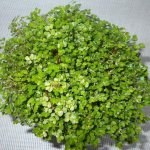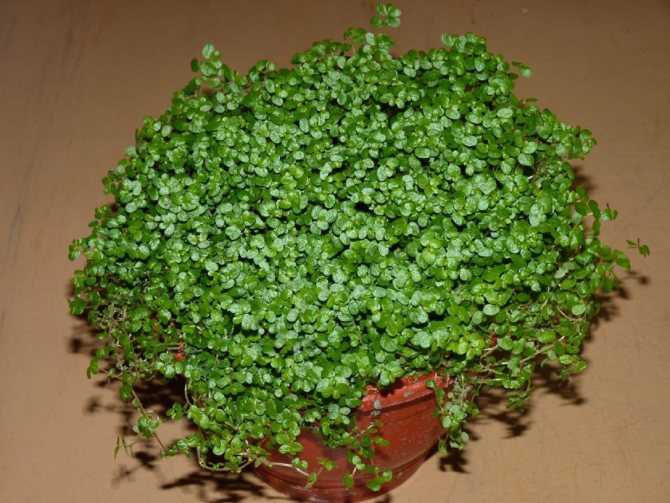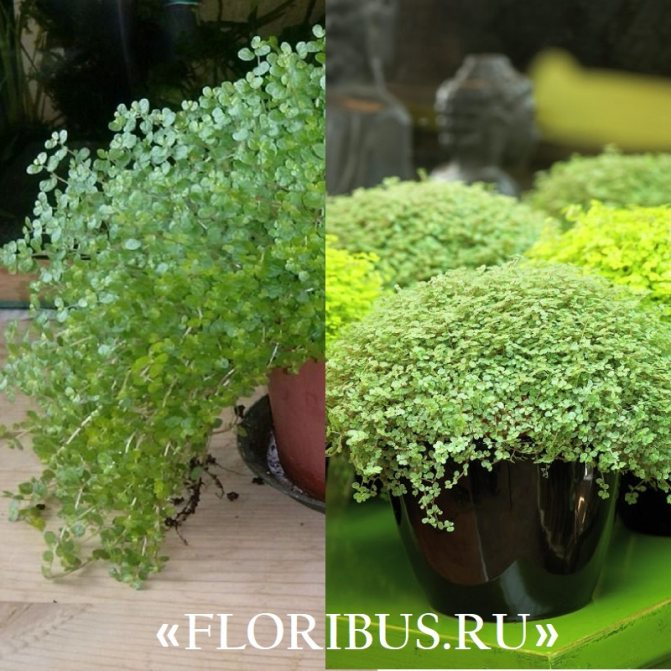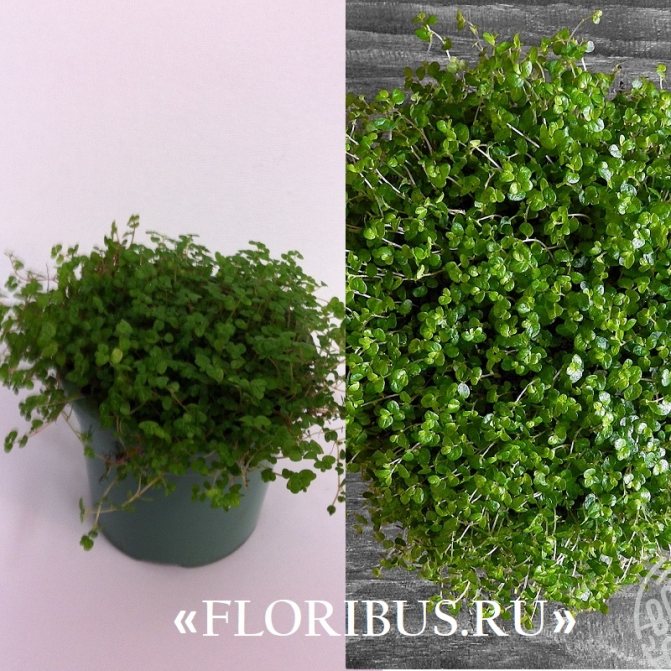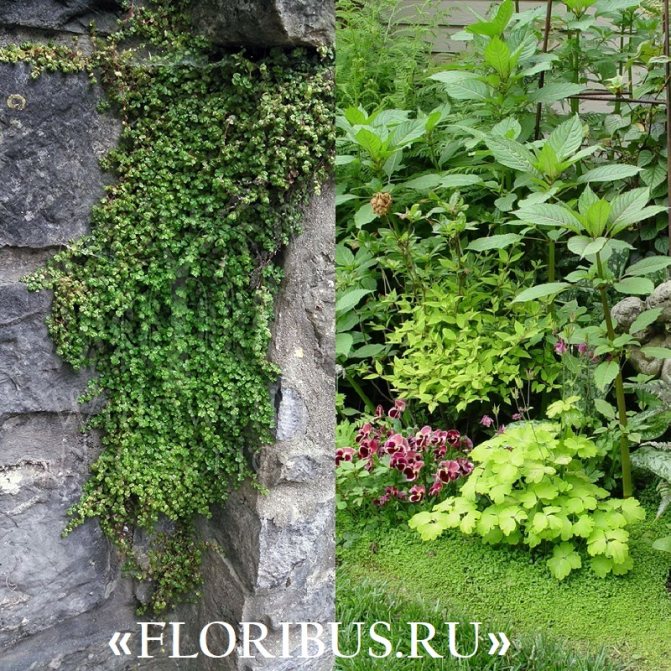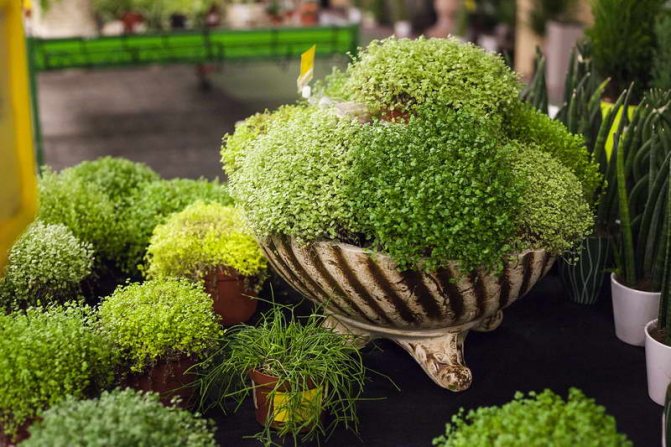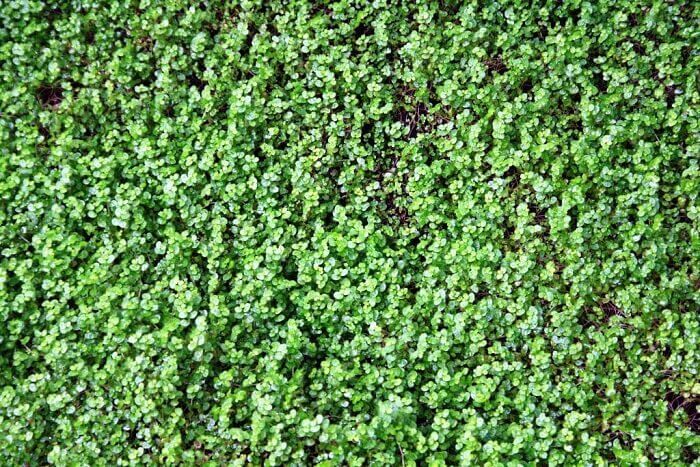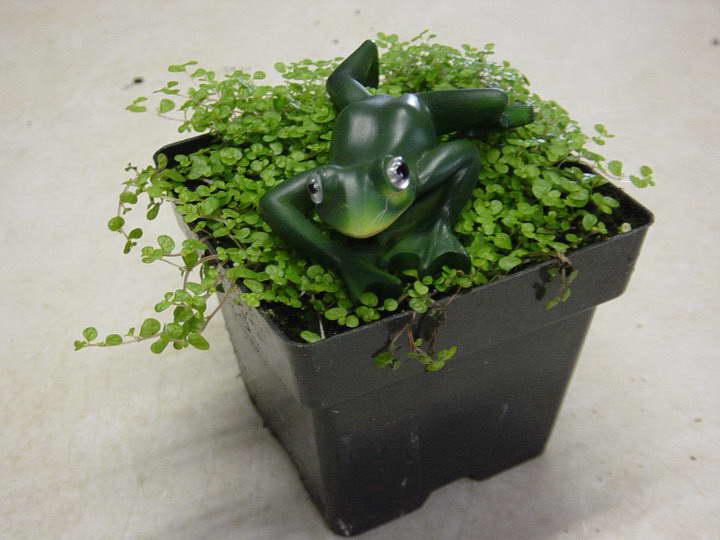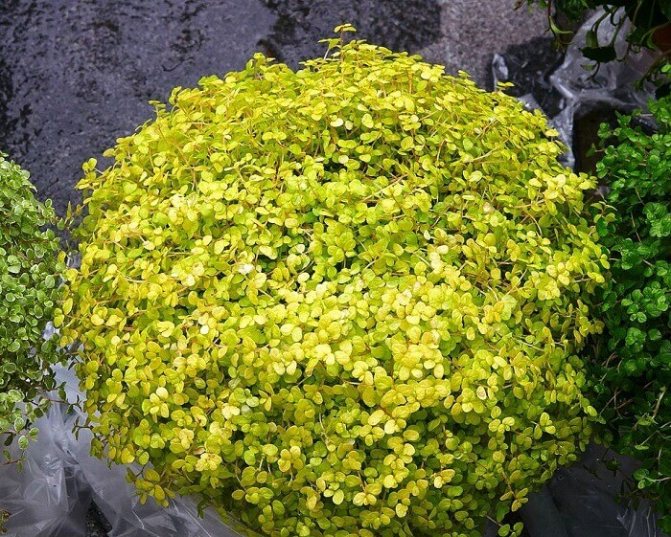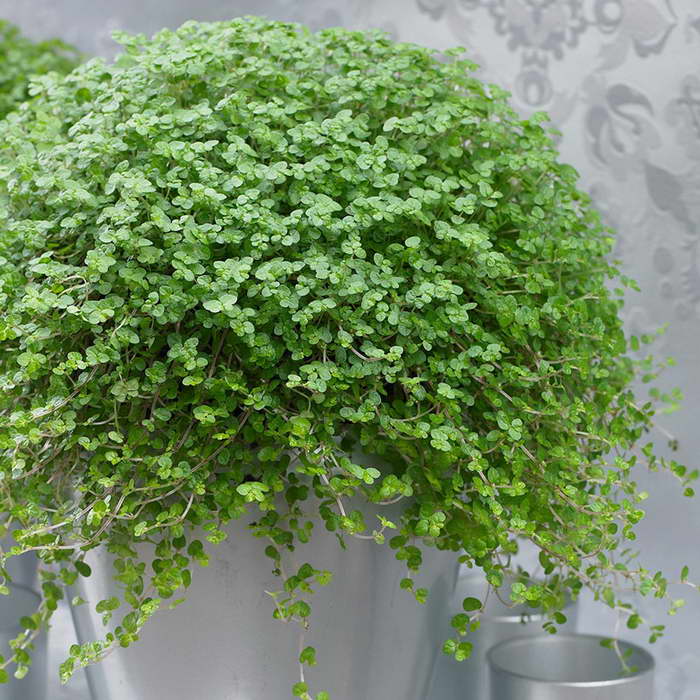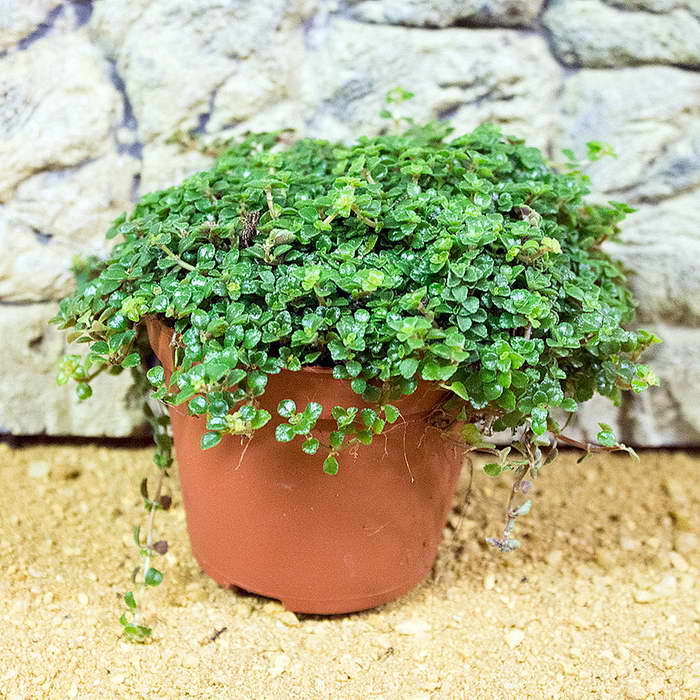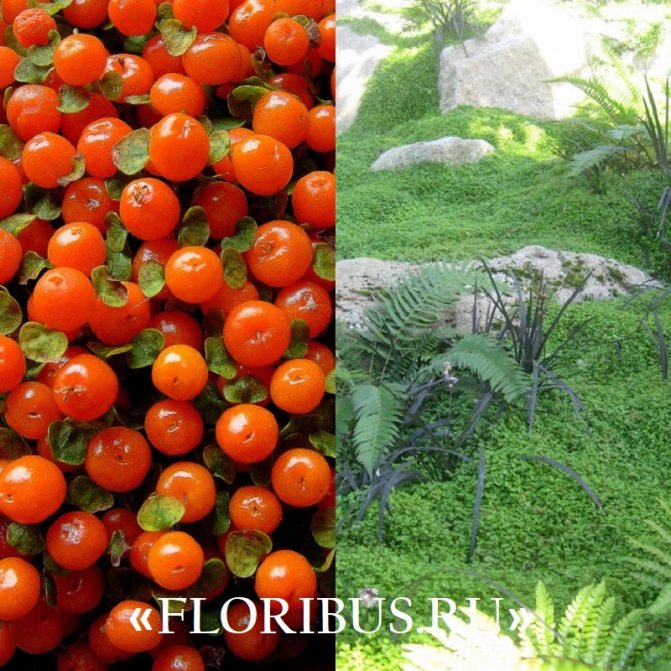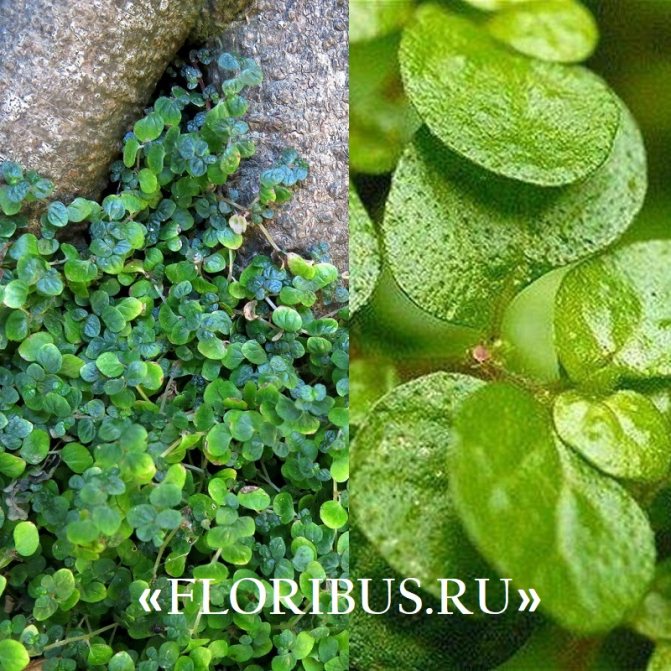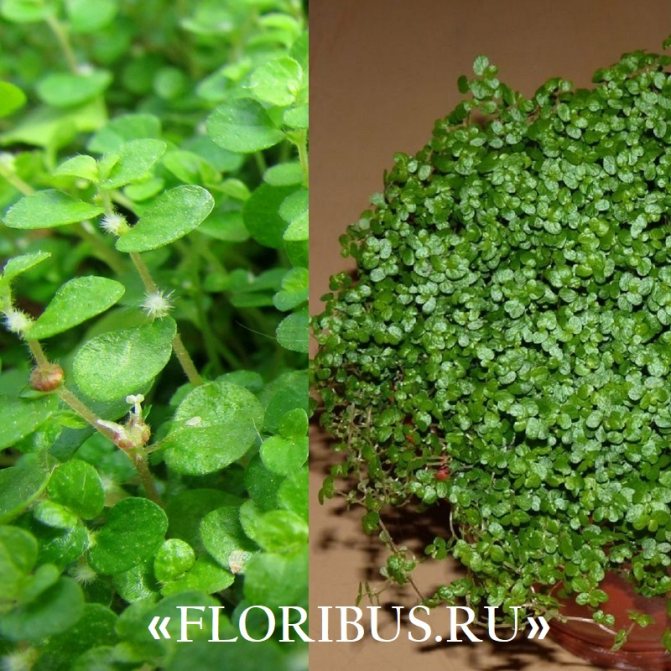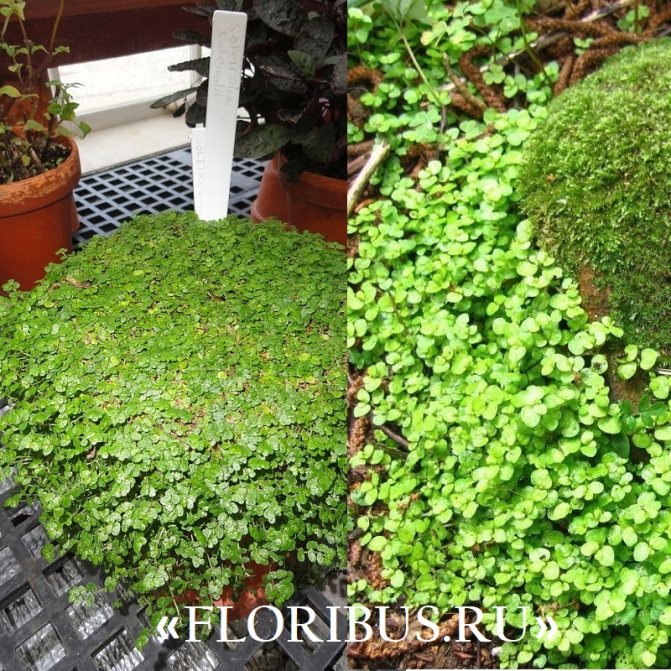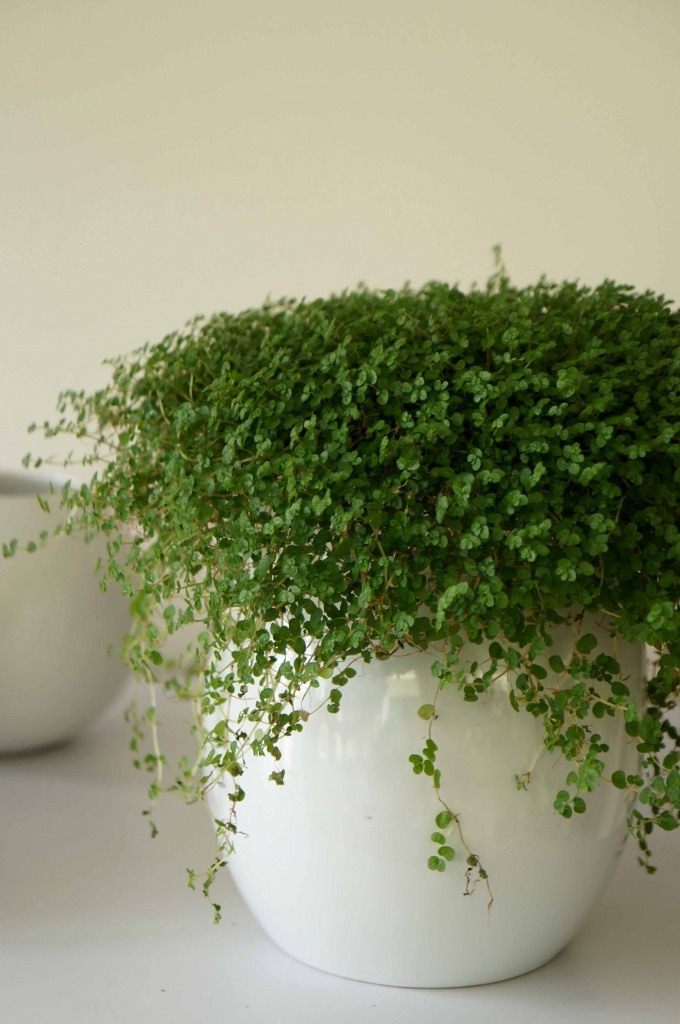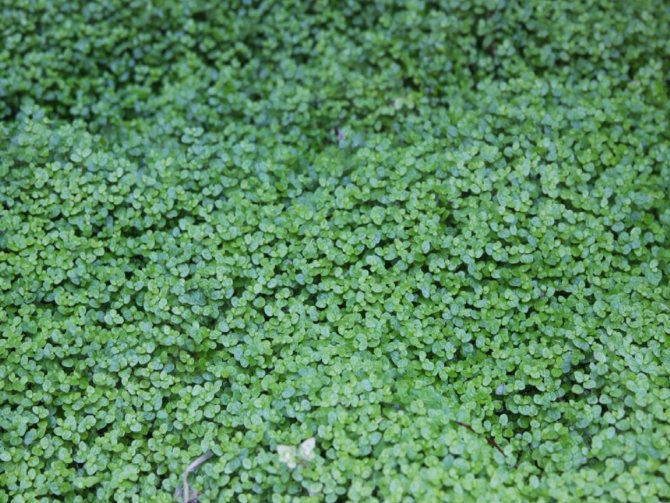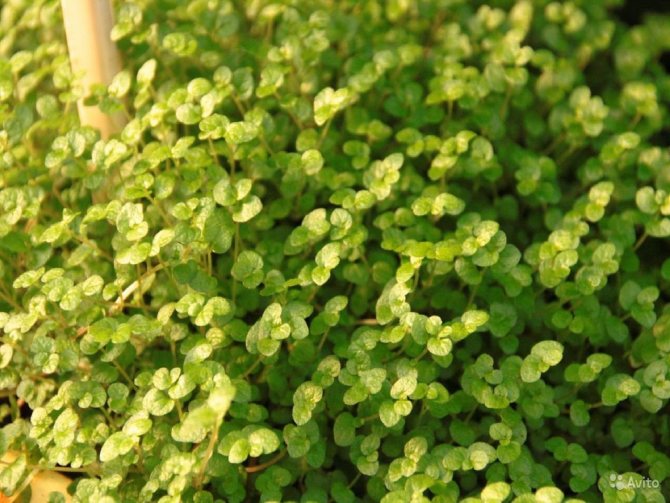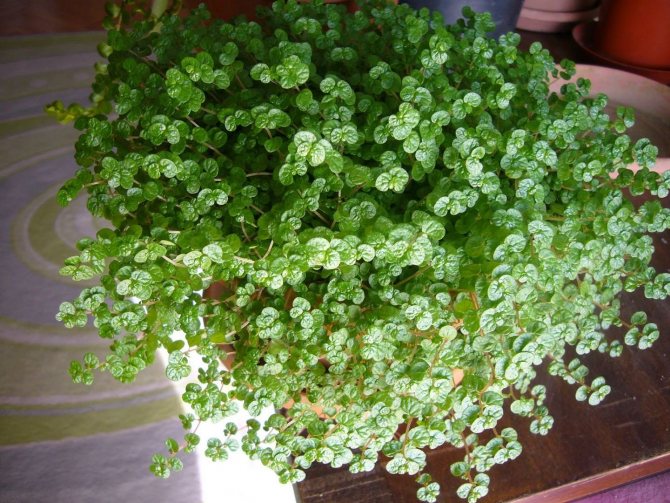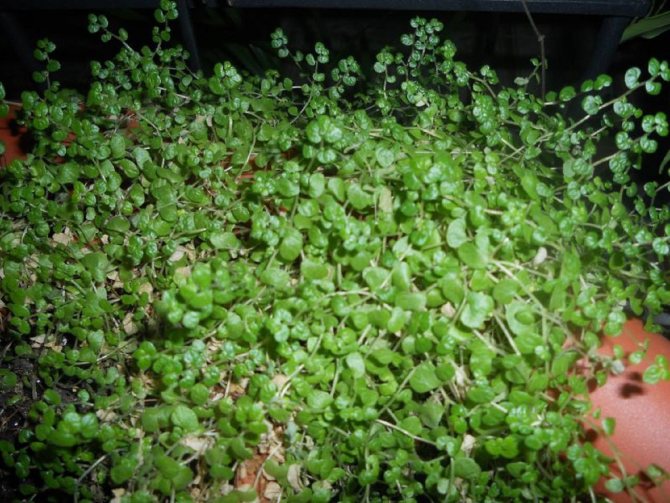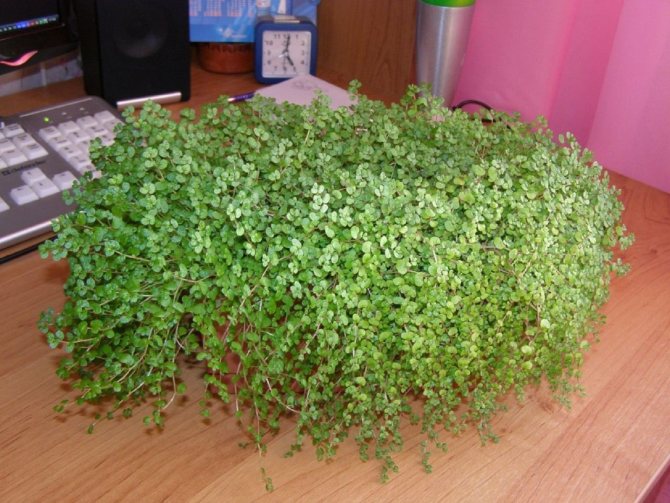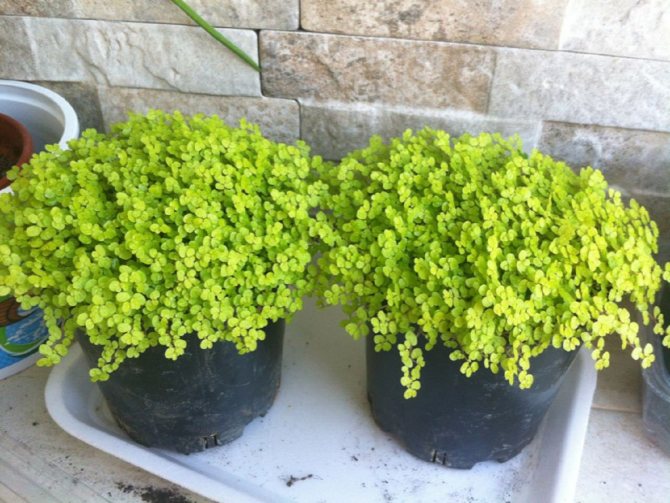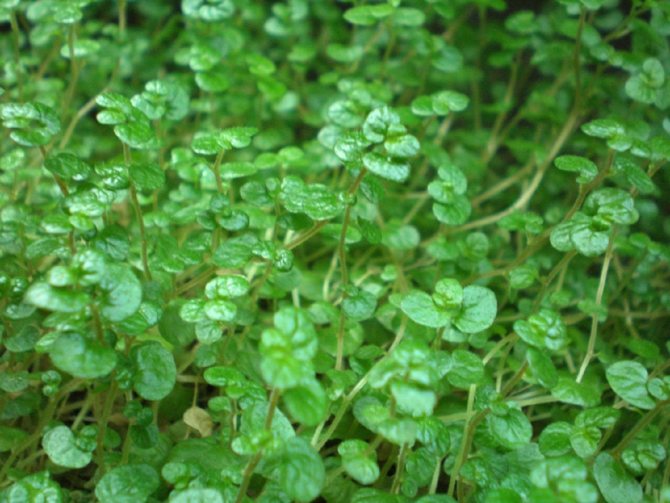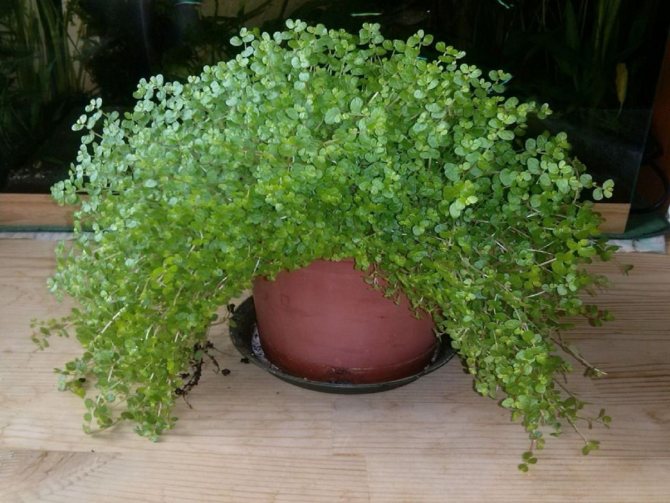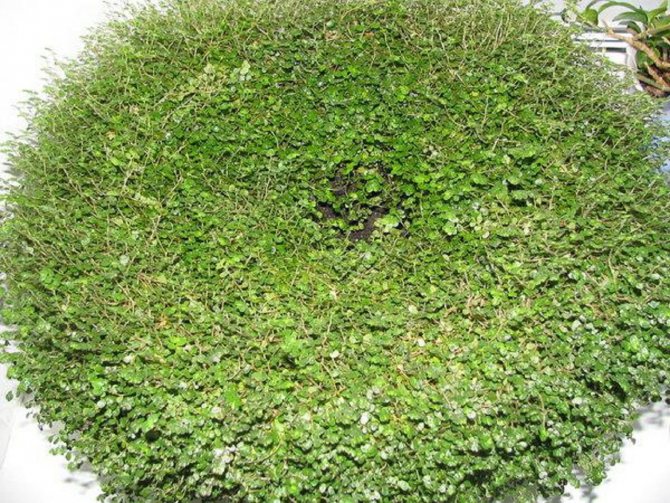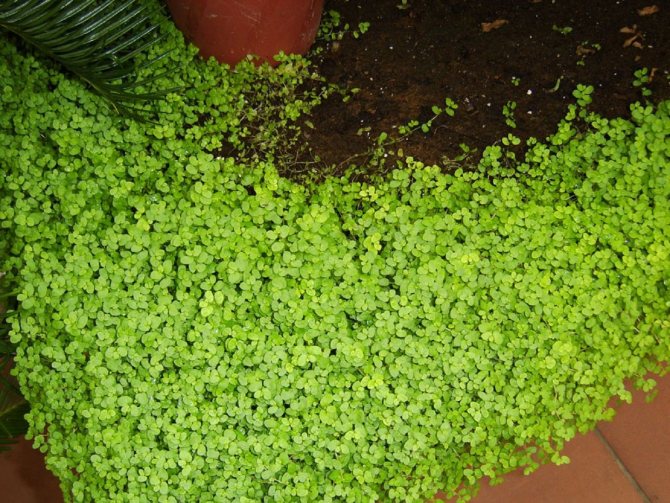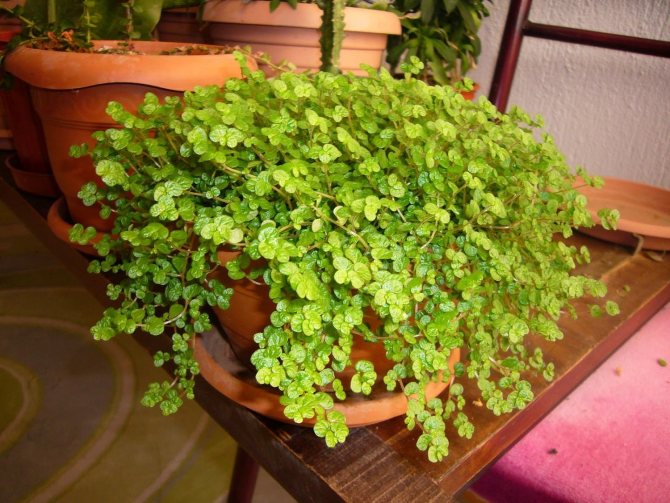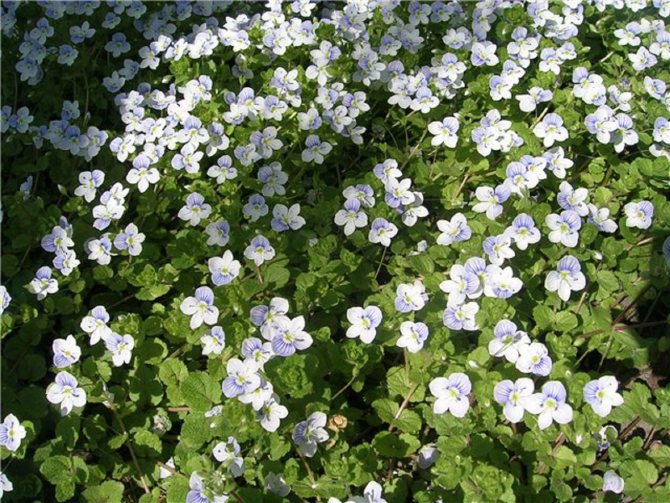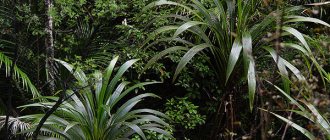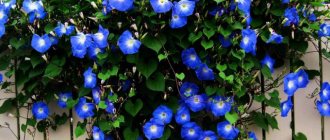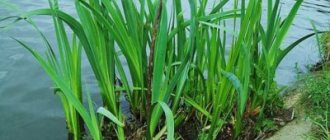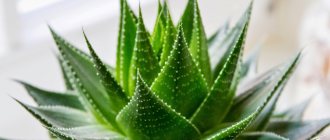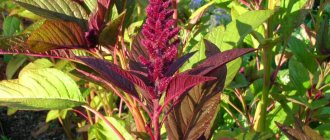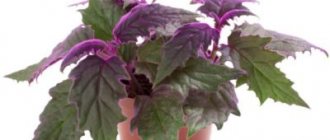Solleyrolia, which belongs to the nettle family, has been cultivated in our country for over a hundred years. Small, carpet-forming plants with thin filamentous shoots, on which small oval leaves "sit", are grown in warm areas as a balcony plant. Salleirolia is cultivated in pots, and it does not form a carpet, but a small "ball".
Soleirolia soleirolii. <>
Genus Soleirolia (Soleirolia), or Gelksina (Helksina) (Helxine) is a monotypic genus of the nettle family (Urticaceae
). The only species is Soleirolia soleirolii.
Soleirolia: description, varieties with photos and videos
Solleyrolia loves when there is a lot of moisture. This bright green plant with tiny leaves is often used to decorate terrariums. Gelksina forms a beautiful deciduous carpet.
Looks good when grown in hanging pots. A freshly planted plant grows rapidly - its shoots begin to hang down. Therefore, if flowers are planted next to it, they will be drowned out by the intense growth of the plant.
It blooms with small white flowers.
The traditional use of gelxina is to be planted as a ground cover plant. One of the most popular options is to plant salturolium with large-sized plants.
It looks good as part of a small garden or small flower arrangement.
Main types
There are several types of gelxin:
- Aurea... The external difference lies in the color of the leaves: they have a yellow-green color. In this form, the shoots are creeping. They have a high growth rate.
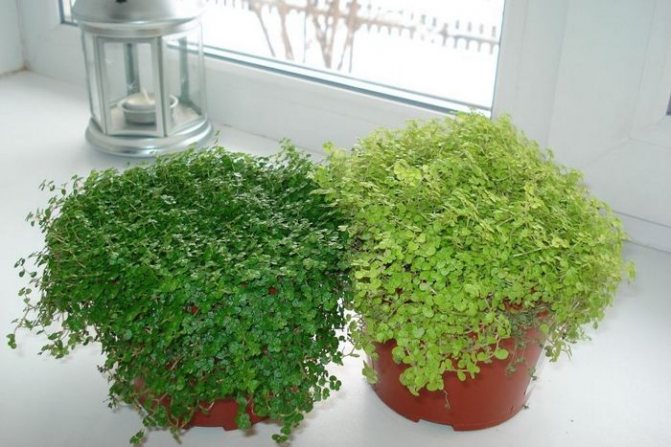
- Soleirolia Green is a bush with a diameter of no more than 20 cm. Miniature leaves are greenish in color.
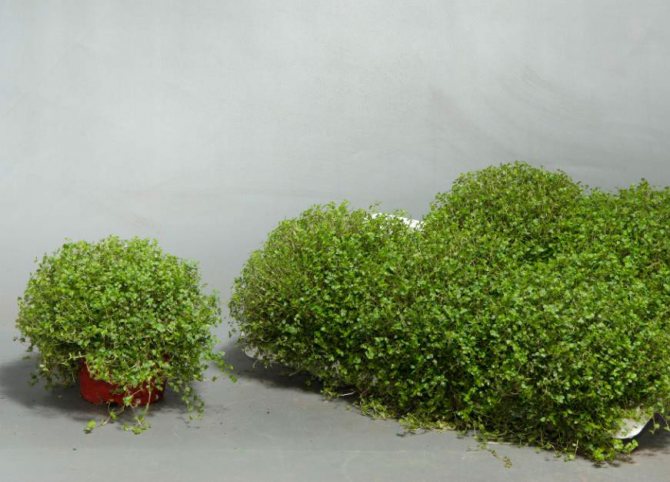

- Soleirolia Argentea is a slender groundcover with slender shoots and filamentous roots. The flowers are creamy or white, of no decorative value. Small leaves of green with a silvery shade are oval in shape. Flowering is rare.
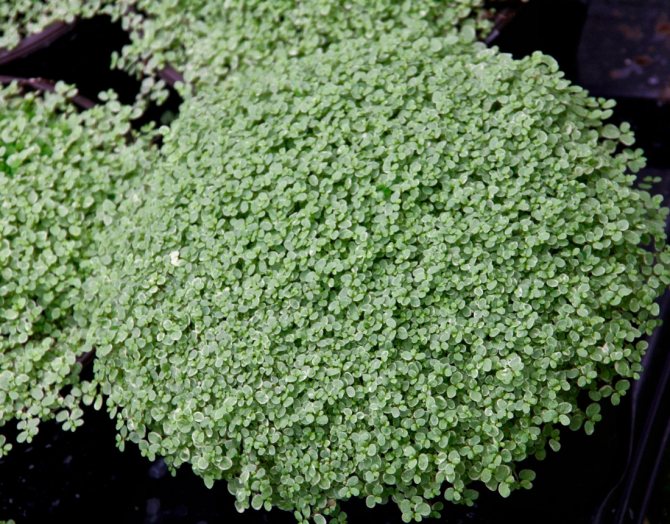

- Soleirolia Variegata has fragile and thin stems. She grows a large number of small green foliage with a lighter border around the edges. When grown in pots, it rarely blooms.
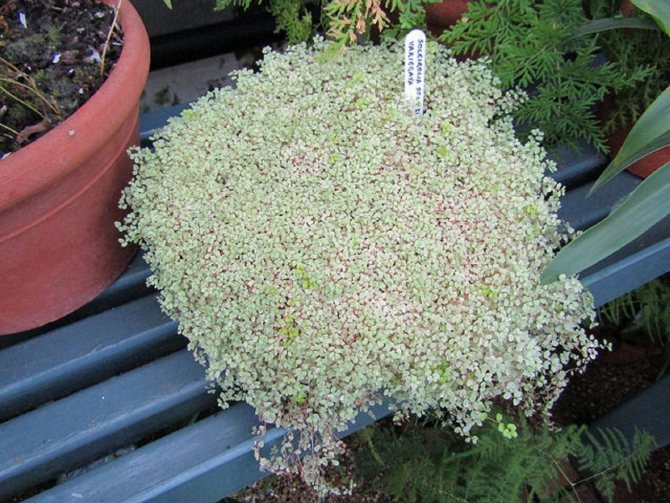

The plant has the following advantages:
- Resistant to low temperatures.
- If you follow the rules of care, it grows well.
- Has a high resistance to insects and pests.
- Can be used to create garden compositions.
It has disadvantages:
- When heated above 25 degrees, it can wither. Does not tolerate overdried soil.
- Too much moisture can cause root rot.
This plant rarely blooms when grown at home, but is widely used as a groundcover in garden compositions.
Botanical description
Soleirolia is a perennial plant with drooping, translucent stems. It has a thin superficial rhizome. Also, air roots are formed in internodes. The height of the ground cover does not exceed 10 cm.
The stems are covered with miniature petiole leaves, which are arranged in pairs. The bright green leaf plate has a rounded or ovoid shape with embossed radial veins. The diameter of the glossy leaves does not exceed 5 mm.For this, saline is often called home duckweed or children's tears.
Occasionally single flowers bloom from internodes. They represent a pistil and a bunch of silvery stamens. After flowering, tiny seed pods are formed. At home, soleurolium sets seeds extremely rarely.
Choosing a place for planting and preparing the soil
Salleurolium is undemanding to sunlight. An area that is shaded and one that is abundantly lit by the sun is suitable for her. However, in the sun the plant will be more powerful and dense, while in the shade it will have thinner and more elongated shoots. If it is grown outdoors in summer, the plant will develop well.
It grows best in soil that is a mixture of sand and leafy soil. Instead of the latter, you can use sod land.
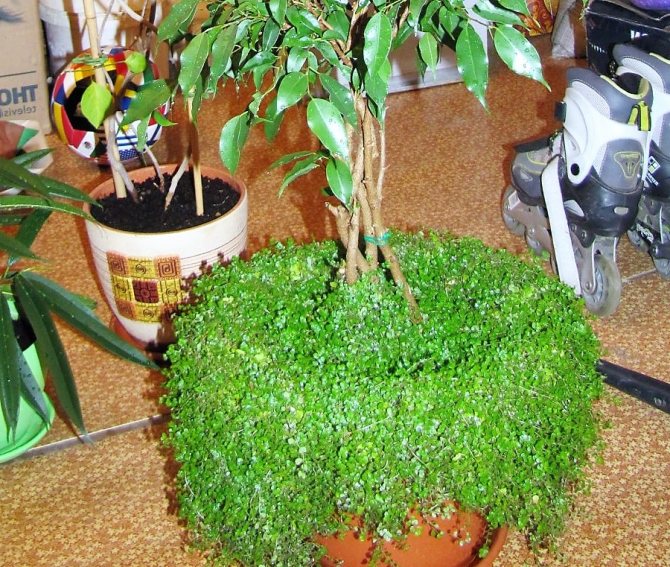

Varieties
In the genus of saltium (gelksins), the only species is registered - Soleirolia soleirolii... Its bright green leaves with a shiny surface are most common. In order to diversify the assortment at least a little, breeders have brought out several decorative varieties of saltérolia:
- argentea - has a silvery leaf color;
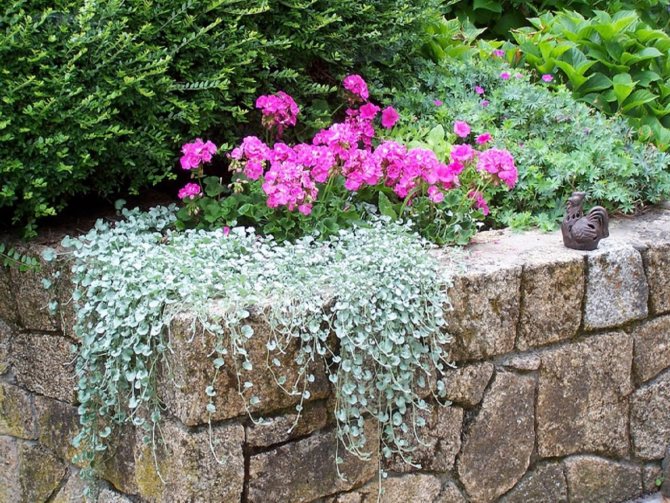

Gelksina argentea - variegata - leaves have a thin snow-white border;
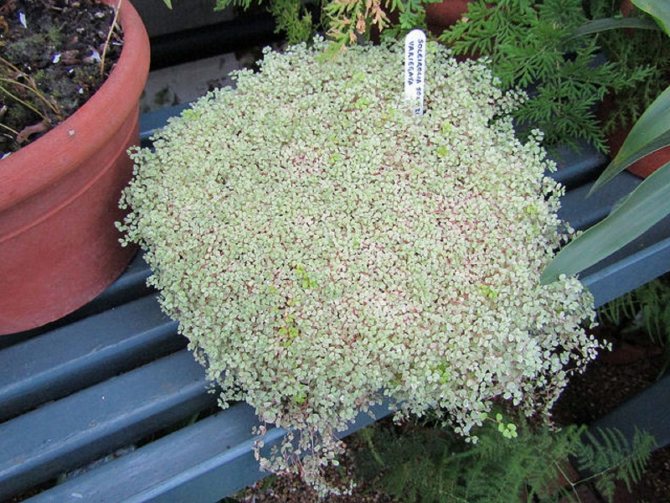

Gelksina variegate - aurea - has yellowish or golden foliage.
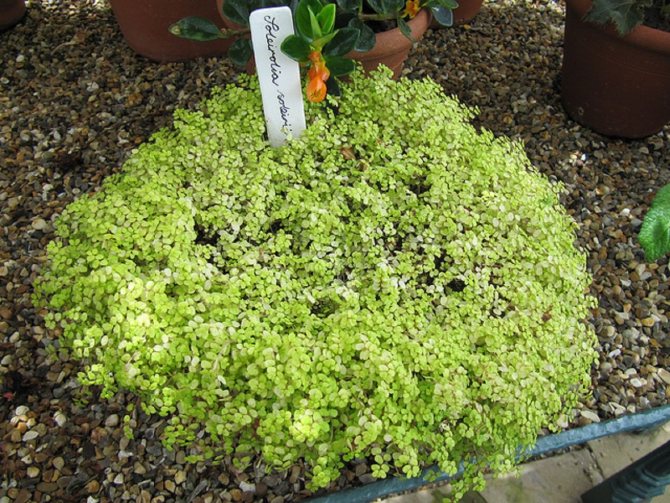

Gelksina aurea
All varietal differences appear in bright light, otherwise the plant acquires its original emerald appearance.
Landing
The homeland of this plant is the subtropics. Therefore, in temperate and northern latitudes, it is grown in pots indoors.
Seedling preparation
After planting the seeds in a container filled with soil, it is necessary to pre-irrigate the soil mixture.
Then the surface is covered with glass or foil. The container is placed where it is warm and there is a lot of diffused light. The planting is ventilated and regularly moistened. After the formation of two true leaves on the shoots, they are seated in separate pots.
Planting plants in the ground
Good drainage is recommended when planting. For this, you can use small expanded clay.
The newly planted plant is watered once every couple of days. As it gets older, watering can be done more rarely - no more than 2 times per week.
When planting in the ground, you need to pick up a loose soil mixture. It is important that the ground can pass air well. The optimal composition can be prepared from peat, turf and sand, taking them in equal parts.
There is a commercially available mixture that works well for gelksina - this is a soil mixture for palm trees.
For transplantation, roots are taken with a lump of earth. In this case, they can be protected from accidental damage during transfer.
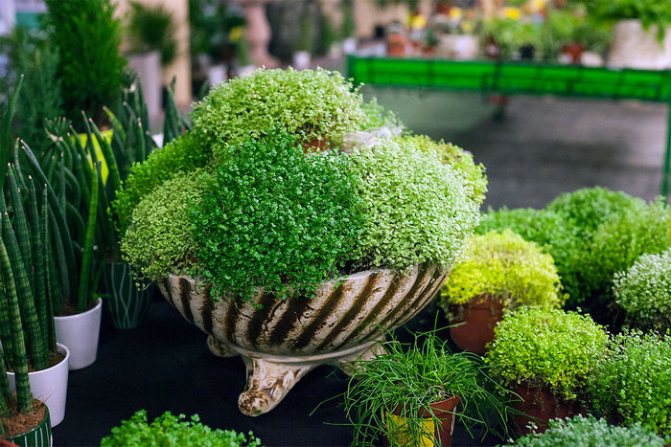

Reproduction and transplantation
In culture, saltworm is propagated in a vegetative way, since it can be very difficult to get seeds. Vegetative propagation is considered the simplest and allows you to preserve varietal characteristics.
To acquire a new bush, it is enough to cut off a young shoot with 2-3 internodes and root it. You can put the shoots in water before the first roots appear, or immediately plant them in moist soil. After 12-20 days, the plant becomes completely independent and actively starts growing. You can dig in part of the shoot without cutting it off from the mother plant. In this case, the rooting process will be even faster.
After rooting, it is advisable to transplant saltyrolia seedlings into a wide and shallow pot. To make the plant more likely to form a dense cap, it is recommended to plant several specimens together.
Transplantation of saltium is carried out as needed, when the rhizome becomes cramped in the pot. Better to plan your procedure in the spring.You can divide the bush into several parts or choose a larger container. In order not to damage the thin roots, the flower is transplanted by the method of transshipment of an earthen coma.
The soil for saltium is composed of the following components:
- sod land;
- greenhouse land;
- peat;
- sand;
- pebbles.
The pot should have large holes for water drainage, and a thick layer of drainage material is poured on the bottom. After transplanting, it is important to keep the salt in a cool room so that it does not dry out too much.
When seed propagation, it is important to purchase quality material. For planting, use flat containers with moistened peat soil. Seeds are sown on the surface, it is not necessary to deepen and sprinkle them with soil. The container is covered with foil. Airing is carried out daily and, if necessary, sprayed with a spray bottle. Seedlings appear in 7-15 days. The grown seedlings dive into separate pots.
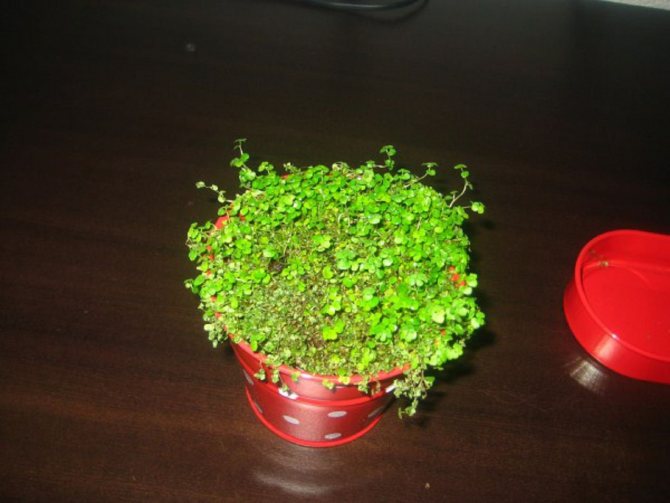

Care features
This plant is unpretentious and practically no special care for saltium is required. It easily withstands drafts, cold or no feeding.
In the wild, the plant is found mainly on the banks of water bodies. It loves moisture and needs abundant watering. It is advisable to additionally spray the leaves with water. However, you need to try to avoid stagnation of water. In such a situation, the roots may start to rot. Optimal watering assumes that the soil is constantly moist, does not dry out completely, and there is no excess water.
Top dressing is performed in spring, summer and early autumn. For her, you can take a complex composition for ornamental plants.
Features of summer care
In the summertime, care is taken to ensure that the ground never remains dry. If this happens, the shoots of the plant will "burn out" from the increased temperature.
It is important for the plant that it is well lit. However, direct rays should not hit the leaves because they can cause burns. The best option would be abundant but diffused lighting.
Features of spring care
In warm weather, the optimum temperature for growing will be 20 degrees. The plant does not like it when the air is heated to 25 degrees or more. If this happens, then it is necessary to moisten the foliage with water from a spray bottle.
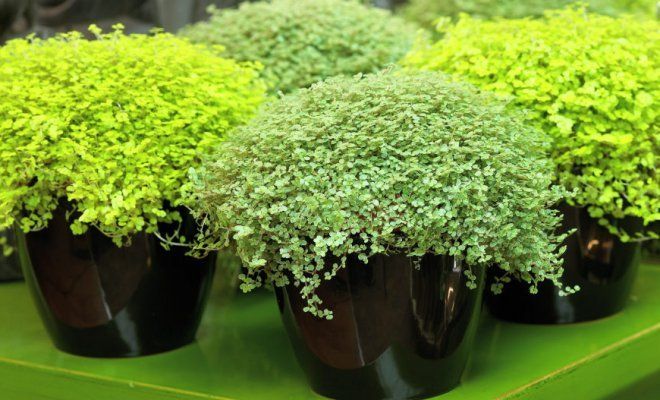

Winter preparation, winter care
The plant tolerates a drop in temperature well. It easily tolerates 5 degrees of heat. However, when the temperature drops further, Helxin temporarily stops rising. With warming, growth is restored.
In winter, watering requirements change. During this period, ornamental shrubs cannot absorb a large amount of water. Excessive watering will lead to root rot and death of the plant. During this time, it is recommended to water once every seven days.
Flowering care
The flowering of the gelxina houseplant begins in the spring and usually lasts for 8 weeks. After its end, the flowers die off - no fruit is formed. At this time, it is necessary to ensure proper watering and feeding.
Diseases and pests
With excessive watering, salt is susceptible to fungal diseases. If the stems begin to turn brown and become soft, then root rot has developed. Inadequate lighting and low temperatures can aggravate the disease. It is necessary to remove damaged areas of the plant, change the soil and treat with a fungicide.
With excessive air humidity, brown or ash spots may appear on the stem and leaves. This indicates a rotting injury. Damaged parts should be removed immediately and the area ventilated more often. To prevent moisture from accumulating on the shoots, it is recommended to switch to ascending or wick irrigation.
Whitefly, spider mites and aphids love the juicy greens of salt. Usually, damaged leaves turn yellow, turn brown, curl or become covered with a thin layer of cobweb.At the first signs of damage, you need to rinse the shoots well with warm water and soapy water. The ground is covered from excess moisture or thoroughly drained after the procedure. If it was not possible to get rid of insects, they are treated with insecticides:
- intavir;
- vermitek;
- actofit;
- aktara;
- phyto-farm.
The substances are quite poisonous, so you should take precautions and keep pets away from the treated plant.
Growing problems
The indoor plant Soleirolia grows well. However, sooner or later, bald spots begin to form, dry shoots appear. If this happens, the plant needs a transplant.
In this procedure, care must be taken, because the roots and shoots of the plant are delicate and can be easily damaged.
When carrying out a transplant, dried shoots and branches are removed. This procedure is actually a rejuvenation of the plant.
Gelksina is usually planted in a flat and wide dish.
Using
Delicate and malleable saltrolium is the ideal material for creativity. If you just plant a plant in a pot, it quickly forms a lush cap, under which the container will completely disappear. Many people like to plant it under indoor trees or large plants to hide unsightly soil. This neighborhood is beneficial if the plants prefer similar conditions.
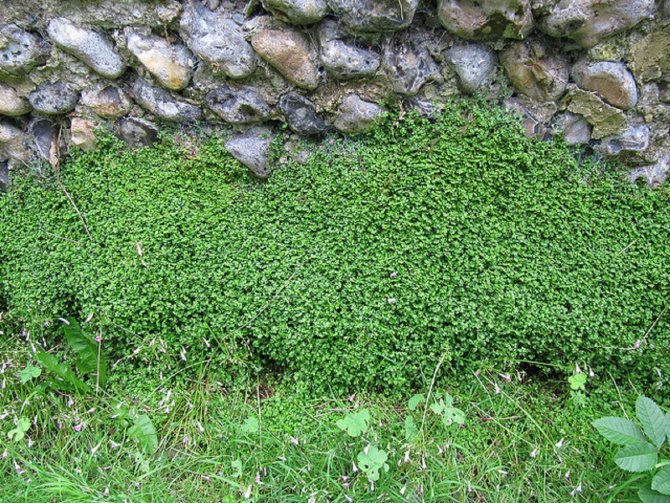

With the help of various varieties of saltérolia, in the garden or on the balcony, you can create a carpet with a pattern of any complexity. It is only important to maintain the boundaries between plants. It is also used for planting in the shade of garden trees or near the shores of water bodies.
Also, the shoots easily braid any support and look great in decorative pots in the form of figurines. If you put salt in them in advance and give it time to grow, you can get a wonderful and unusual gift for a lover of indoor flowers.
Soleirolia is suitable for decorating aquariums and terrariums, but it cannot stand being in the water all the time. A small pedestal is usually created for the pot. Thanks to their miniature foliage, small plants are used for bottle gardens.
Comfortable conditions
- table
| Lighting | The plant loves diffused light. Grows well in partial shade. In order to preserve the bright greenery during the winter months, artificial supplementary lighting is necessary. |
| Temperature regime | A temperature of +20 degrees in summer and +8 degrees in winter are the optimal parameters for plant development, at +5 the growth of shoots stops. |
| Humidity | The plant loves moisture. In hot summer, it is necessary to spray several times a day. In cool weather, moisturize twice a week. |
| Watering | In warm weather, watered as the soil cover dries. In winter, watering twice a month is sufficient. |
| Fertilizer | It grows better with mineral fertilizers. Fertilization algorithm: from spring to early autumn in two weeks. When the plant enters the resting phase, the amount of feeding is halved. |
| Transfer | As soon as the pot becomes small for a sprawling bush, the plants are transplanted. |
| Pruning | Pruning is necessary to form a neat shape and remove dried stems. |
| Reproduction | New plants can be grown from seeds, but this is a laborious process. Soleirolia is not afraid of dividing the bush, cutting off the shoots from which a full-fledged plant grows. |
In the room, saltium is placed in a hanging planter, on a high stand - the shoots hang beautifully, forming a dense growth. Ground cover properties are used in large pots, where tall houseplants are planted - delicate leaves will quickly "tighten" the entire surface with a green carpet.
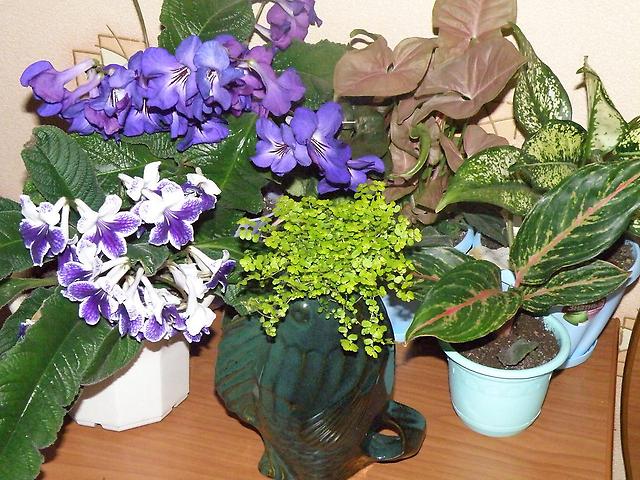

Salleurolium greens look great next to other indoor flowers.
Important! Soleirolia is often planted on the bare trunks of dracaena, yucca, and palm trees.However, it should be remembered that she is quite aggressive and can strangle her more fragile neighbor.
Soleirolia is perfect for decorating open-type florariums, in which a humid microclimate is maintained.
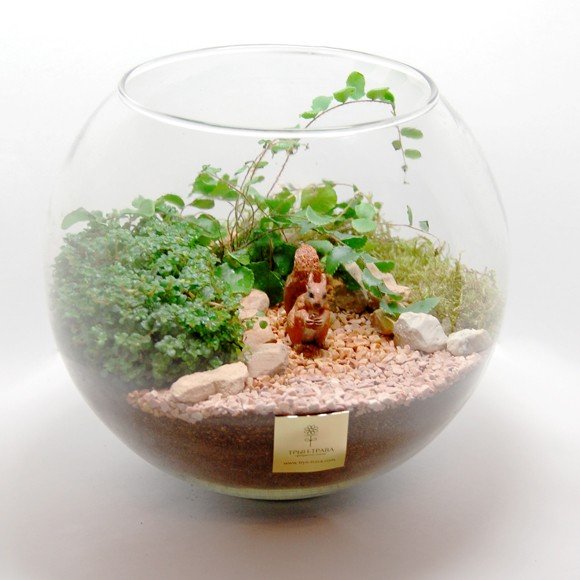

Soleirolia feels great in the florarium
For reference. Florarium is a plant composition in a glass vessel: a tall glass, a vase, an aquarium. A garden in a bottle, representing a miniature of a tropical rainforest or desert, is created from living plants, moss, pebbles, snags.
Soleirolia seed cultivation
Since the decorative characteristics of the plant, four years after planting, begin to deteriorate noticeably, one should think about its renewal, or rather, about how to propagate gelksin.
Reproduction can be done by cuttings, seeds, bush division and shoot rooting.
For seed propagation, use seed purchased from a flower shop. For sowing, prepare a container with soil for palm plants.
Then it is necessary to sow seeds into it by spraying the entire surface of the soil mixture with a spray bottle. Further, the container must be covered with a film and removed to a warm place, providing the seeds with diffused light.
From time to time it is necessary to remove the film, spray the seedlings and ventilate the greenhouse. Once the seedlings have germinated, they should be planted in pots for permanent cultivation.
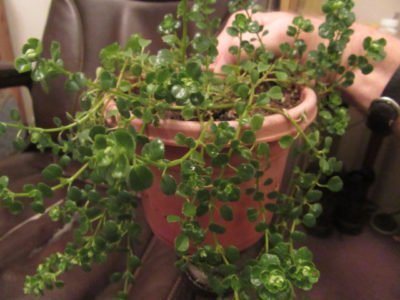

Saline care at home
During the growing season, the plant needs constant watering and high humidity, but within reason. Absolutely do not allow the earthen coma to dry out to the end, even a one-time phenomenon can destroy the plant. Do not pour, keep only the surface of the substrate slightly damp. Since the soil is covered with greenery, the water is simply poured into the sump little by little. During the cool wintering, the helksina practically does not need watering.
When the air temperature is above 20 ° C, salt must be sprayed daily. At temperatures of 18-20 ° C, spray every 2-3 days. If the indicators are lower, it is impossible to carry out the procedure so that rot does not develop.
For both irrigation and spraying, use warm, softened water (after rain, melting ice, filtered or settled for 1-2 days).
When grown in suitable soil and annually transplanted, there is no need to feed Saltrolium. If desired, from March to the end of September, apply a complex mineral fertilizer for decorative deciduous crops to the soil every 14 days. Thanks to this, Gelksina bushes better.
Photo
You can visually familiarize yourself with the gelxin (salt) plant in the photo below:
Main varieties
There are few varieties of saltérolia known among flower growers. They often have uniform morphological features, with the exception of foliage color. This made it possible to use the view for the decorative arrangement of any landscape, as well as the interior.
Most often, the following varieties of salt can be purchased on the market:
- aurea - differs in foliage of a rich yellow-green or ash-colored;
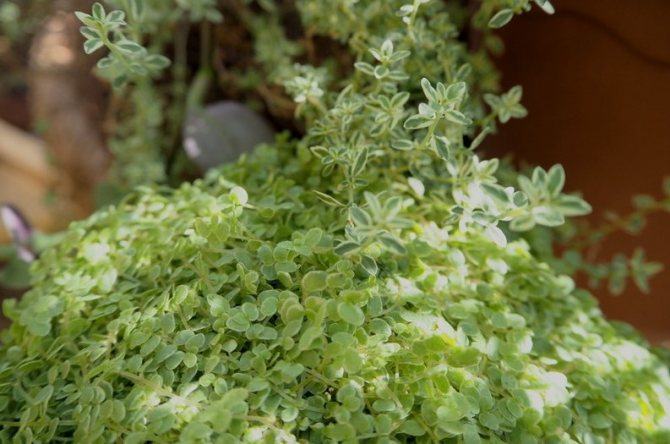

- argentea - has a rather rare light silvery leaf color;
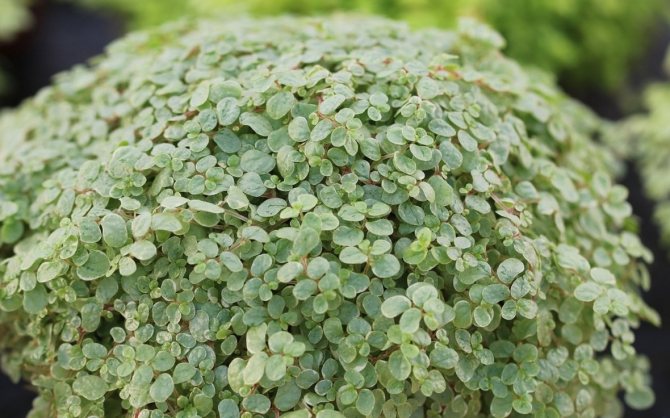

- green - the plant is remembered for its rich light green leaves. Unlike other varieties, its foliage grows no more than 2 mm in diameter;
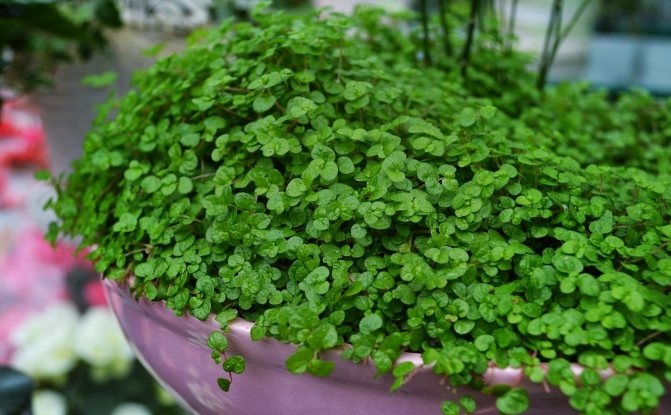

- variegata - the variety is characterized by leaves of a rich dark green color, with a thin white border.
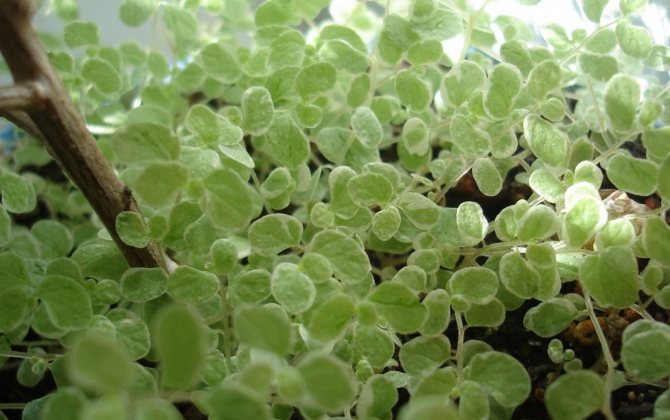

Photo gallery
The flower can be placed in the bedroom of adults and children as it purifies the air and protects against smog.
Thanks to its cleansing properties, saltrolia has even been called the “queen of industrial areas”. The plant does not emit any toxic substances.
Where to put the salt
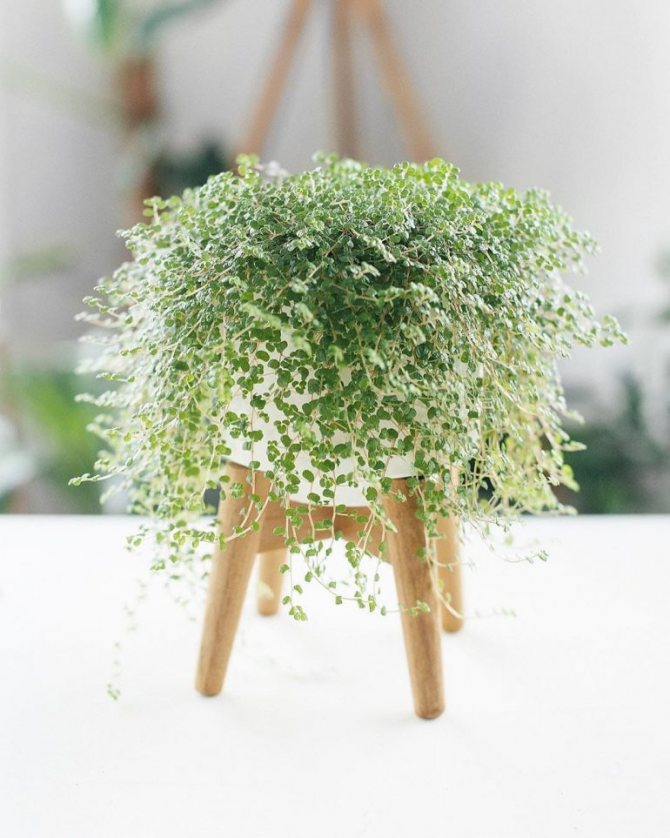

Despite the fact that saltium is one of the light-loving plants, prolonged exposure to sunlight can lead to a loss of decorativeness, curling of leaves and a change in their color. It does well in slightly shaded areas and even in shade.
Soleirolia can be located at the east, north and west windows, in any corner of the room, where natural light enters. If there is not enough lighting, the bush will lose its splendor.
Gelksina: the nature of growth
The small leaves of gelksina can be kidney-shaped or heart-shaped, but it also happens that they are round. The leaves are located on short petioles that densely cover short stems.
By itself, Gelksina Soleirole is a creeping plant that grows up to 10 cm in height. Very soon after planting, the plant very quickly covers the entire surface of the earth in a flower pot.
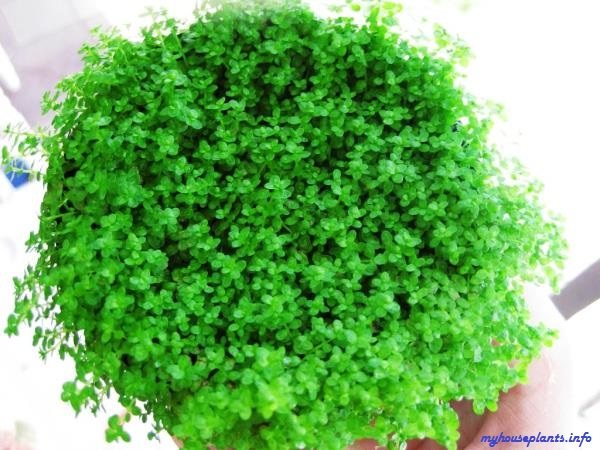

Charming and without flowers
The plant doesn't have to be flowering, right? Ornamental deciduous plants are often the most beloved, which give a sense of harmony and tranquility. And their simplicity in care makes them especially valuable for decorating premises. The heroine of this article belongs to the category of similar ones.
Soleirolia (Soleirolia) or Gelksina, Helxine (Helxine) is a perennial herb of the Nettle family. Cultivated at home for over a hundred years!
Its delicate, thin, almost threadlike shoots are densely covered with oval, coin-like leaves. They are 0.5 cm across, sessile, light green in color, and have a glossy surface. The leaves appear heart-shaped at the base. During the period of active growth, new shoots grow from the sinuses, intertwining with each other in a continuous mass. As it grows, a ground cover effect is created, or more correctly, a thick cap of greenery rises, a ball is formed. The height of such a mound is 5 cm. The roots of the plant are thin, but it is not difficult for them to hold such a mass.
Helksina blooms inconspicuously. Corollas are small, whitish, solitary.
Homeland of the plant
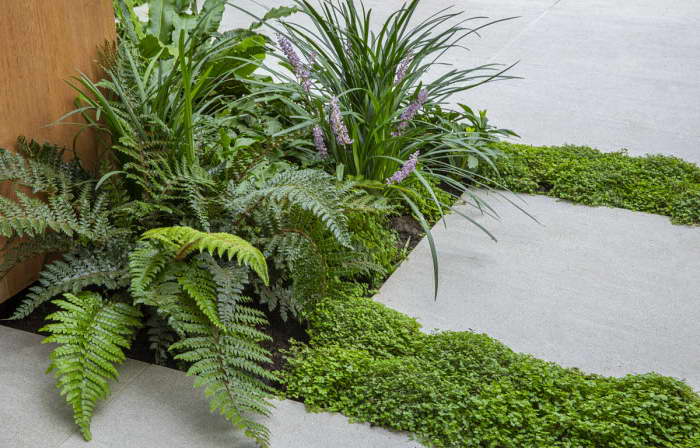

Soleirolia in interior design photo
Solleyrolia is thermophilic. Its habitat is the Mediterranean, the islands of Sardinia and Corsica, where it settles on rocky wet areas in shade, often grows along the banks of streams. In regions with a warm climate, gelxina is cultivated as a balcony plant.
Under room conditions, it is grown as an ampelous culture: the shoots hang in a continuous stream over the edges of the container. You can put the pot on a stand, table. Helksina is successful in bottle gardens, terrariums, and is used to decorate the corners of the aquarium. The ground cover is also planted in pots to frame the foot of large plants or small trees, it will drown out small flowers. You can grow saline in the winter garden.
Superstitions and omens
Since saltium is a very tenacious plant, it is suitable for beginner flower growers. And it can also be safely grown in a house where there are pets or children, since this flower does not contain any toxic substances.
Experts say that this plant helps to neutralize the negative in the house, as well as to strengthen the health of its owner. It can also absorb negative energy emitted by household appliances and refresh the atmosphere with its positive energy.
Errors and their elimination
| Error | Cause | Correction |
| Withering leaves, they dry up and die off. | Moisture deficiency, insufficient air humidity. | Spray daily. Place away from heaters. |
| Pulling stems, blanching foliage, slow growth. | Insufficient amount of useful elements in the soil, little light. | Feed the plant with a compound fertilizer.Rearrange in a sunny place, supplement with phytolamp. |
| Drying of foliage, the appearance of gray-brown spots. | Exposure to direct sunlight. | Move to partial shade. |
| Yellowing and falling leaves. | Excess moisture. | Reduce the number of waterings. |
Priming
The most suitable option for planting saltwort is humified soil. You can purchase a ready-made potting mix in a store, a universal soil, soil for decorative deciduous plants, violets and palms is suitable. When buying, you should pay attention to the acidity of the soil - it should be neutral or low.
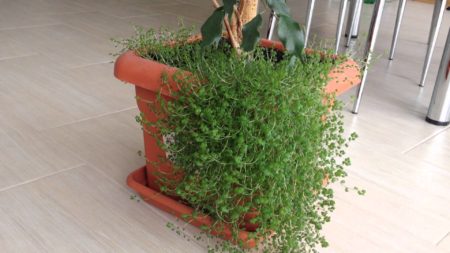

The soil mixture can be prepared independently by mixing leafy soil, peat and sand in equal proportions. Add a small amount of small pebbles to the resulting mixture to make it looser and more breathable.
If you prepare the soil yourself, it must be calcined or steamed for disinfection purposes.
For gelksina, you need a wide and shallow pot-bowl with a capacious tray for bottom irrigation, you can also grow it in florariums or terrariums. In any case, at least 2-3 cm of drainage must be laid on the bottom.
Expanded clay, large pebbles, perlite or vermiculite are used for drainage.

